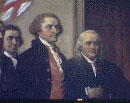 |
||
  |
||
|
|
Jefferson vs. Franklin: Renaissance MenIntroductionAt a dinner honoring Nobel Prize winners from the Western Hemisphere, President John F. Kennedy paid homage to Thomas Jefferson's wide-ranging interests and talents when he remarked, "I think this is the most extraordinary collection of talent, of human knowledge, that has ever been gathered together at the White House, with the possible exception of when Thomas Jefferson dined alone." Although the term 'Renaissance man' was not coined until the nineteenth century, Jefferson has become, for us, its exemplar. Under different circumstances, President Kennedy could have invoked Benjamin Franklin's name as well. If we compare his achievements with Jefferson, Franklin would equally qualify as a Renaissance man. Yet when one thinks of a Renaissance man from Colonial America, Jefferson invariably comes to mind first. Was Jefferson simply the right age at the right time? Or do his achievements justify his preeminent position? Has posterity given short shrift to Dr. Franklin? Who would your students select as the undisputed champion Renaissance man of the Founding Fathers? Note: For additional activities comparing the achievements of Franklin and Jefferson, see the complementary EDSITEment lesson plan Jefferson vs. Franklin: Revolutionary Philosophers. Guiding Question:What were the achievements of Franklin and Jefferson in their various fields of interest? What connections existed between their shared thirst for knowledge and individual political philosophies? Learning ObjectivesAfter completing the lessons in this unit, students will be able to:
Preparing to Teach this Lesson 1 Begin by sharing
this quote from President Kennedy (and its context, as noted in the Introduction,
above): What did President Kennedy mean? Tell students that Jefferson is one of a number of important figures in the American Revolution who had very wide-ranging interests. Ask them to hypothesize why an interest in freedom and democracy and a thirst for knowledge are complementary ambitions. Tell students that Benjamin Franklin is also known for his wide-ranging interests. Brainstorm as a class the achievements of each man with which students are already familiar; write the list on a chart to reflect on later. Explain
to students that the term "Renaissance man" is used to refer to someone like Jefferson
or Franklin who has knowledge in many fields. Are there any Renaissance men or
women in your class? Generally, Jefferson is cited, as in the Kennedy quote above,
as the greatest Renaissance man of the colonial period. Suggest that some people
believe Franklin has been underrated in this regard. The assignment for the class
is to prepare for a debate on the matter. Which Founding Father deserves to be
declared the undisputed champion Renaissance man? The assignments are as follows:
Students can use the following EDSITEment resources to conduct their research. Before they begin, make clear to the class your ground rules for computer use. Remind students that they must make note of the sources from which they derive information. For website citations, the URL and title should suffice, allowing students to refer back to the site as needed. For downloaded information, refer to the document name and source URL. Thomas Jefferson
3 Once research is complete and the "competition" is set to begin, students should assemble in their groups on either side of the room. Appoint or have the class invite guests or students from the class who can be objective to serve as judges. NOTE: Only the chair of each group can offer points from the group, though group members should be able to consult with the chair as needed. Flip a coin to see which group goes first. The chair of the first team names a field of endeavor and specifies an achievement; the chair can suggest a field of endeavor not on the chart, to be listed as an "Other." If the opposing team members can offer an achievement in the same field of endeavor, they do so. If they cannot, that area is closed. The judges decide if two achievements are equivalent, if a suggestion deserves to be termed an achievement, and if an achievement truly belongs in a newly established "Other" category. Achievements are then entered in the appropriate place on a master version of the "Franklin versus Jefferson" chart on page 1 of the PDF file (see Preparing to Teach This Lesson, above, for download instructions). Next, the second team offers an achievement that the first team attempts to match. Competition continues until achievements—or class time—are exhausted. If desired, the chart results can be scored as follows (as an example): five points for any uncontested area of achievement, one point for every unmatched achievement. An alternative to the above is to conduct a conventional debate with teams taking positions: Jefferson should be regarded as the champion Renaissance man; Franklin should be regarded as the champion Renaissance man. The
structure of the debate could be as follows:
The
debate could be judged on a point basis, as shown on the "Scoring Sheet for Debate"
on page 2 of the PDF file (see Preparing to Teach This Lesson,
above, for download instructions). Extending the Lesson
Standards Alignment View your state’s standards |
||||||||||||||||||||||||||||||||||||||||||||||||||||||||||||||||||||||||
  |
||
| EDSITEment contains a variety of links to other websites and references to resources available through government, nonprofit, and commercial entities. These links and references are provided solely for informational purposes and the convenience of the user. Their inclusion does not constitute an endorsement. For more information, please click the Disclaimer icon. | ||
| Disclaimer | Conditions of Use | Privacy Policy Search
| Site
Map | Contact
Us | ||
